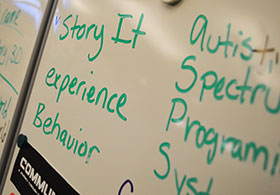| Editor’s Note: Students in 3D Animation are working on a huge project to help those with autism become more successful in social situations. These efforts are drawing attention and help, both locally with an area technology company, statewide as Michigan’s winner in the Samsung Solve for Tomorrow contest, and now nationally as one of 10 finalists across the country.As a finalist, students have already won $50,000 in Samsung technology and may win even more once they pitch their project to judges in New York City. Readers can see the video about the Tech Center’s Autism Project and participate in a community choice voting campaign at the ‘Samsung Solve for Tomorrow Competition‘ website. Voting takes place right on the website, with additional votes for sharing on social media. Videos from all of the national finalists can be found on this site.When Principal John Kraus heard the news, he was very excited for his students and “so proud of the work of the team that put this together…I have high hopes for doing well nationally…but even higher hopes for the impact of this tool with the autism world!” |
For months now, in a digital technology program at Kent Career Tech Center, nearly 40 high schoolers propel themselves into a real-world project in digital design, animation, graphics and game-making — all to help students with autism.
Wearing a Darth Vader-like hoodie and earbuds, Forest Hills Eastern senior J’Lon Johnson, concentrated on the big picture — connecting learning to real-world outcomes.
“Our virtual reality experience is similar to an educational game because it functions like a game, but it is meant to be both entertaining with video play value and practical for students with autism to practice their social interactions,” J’Lon said. “The awareness for this – helping (autistic students) understand the nuances of social cues — is super low and even when people are aware, they are not actively trying to fix the problem. But we are.”
Students are using the Design Thinking Process from Henry Ford Learning Institute to create “an immersive training simulation so they can practice their social skills in a virtual reality environment. …(I)n person, they might have some fear,” said Marc Petz, 3D Animation instructor at Kent Career Tech Center. “We’re calling it Social Skills Behavior Training.”
“The autism project (is) like an industry project. We created a studio in a classroom like a proper workplace,” said Petz guiding the students through the many stages involved in creating a virtual reality experience. “All the students are in their own groups whether it’s a 2D department, 3D department, animation or whatever. They are working as a group with a tech team leader.”
Students work to refine their prototype during class in one of three areas:
- Pre-production that includes writing scripts and drawing storyboards with panels much like a graphic novel
- Production which involves transferring 2D into 3D animation by harnessing the whole environment and
- Post-production when they refine their virtual reality experience with final tweaks, edits and sound edits

Bringing a Story to Life
At a computer workstation, Leanne Imkamp, Sparta High School senior, is creating a series of panels for the animated storyboard for the virtual reality autism project. Each panel looks like the drawings you might find in a graphic novel. “So pretty much what I’m doing is making any movement – any poses – that the character might make because this will help the animation crew know how to pose them,” Leanne said.
Nearby Cody King, Forest Hills Northern senior, is tweaking the visual development of the 2D storyboards so he can begin to build the 3D environment on his computer. Cody said, “we’re making sure there are no bugs and we won’t crash immediately. So a lot can go wrong creating the actual environment.”

Leanne Imkamp, Sparta High School senior, worked on animated storyboards
As they sculpt the set, props and characters, the students grapple with making everything look believable. “I need this guy to walk like a normal person,” said Mcguire VanderWall, South Christian High School senior.
Mcguire, along with two other Tech Center students – Grandville High School senior Hailey Benefiel and Comstock Park High School senior Jessica Osmun, are also interning this semester at YETI CGI, a Wyoming-based design and development studio. Support from this company allows students to continue working on the project as part of their internship, after their Tech Center class ends for the day.
“The YETI staff, several of whom are former college professors, are providing invaluable mentoring and technical assistance to our students, and we are so grateful,” said Laura Robinson, a Kent ISD instructional coach. “We couldn’t do this without them.”

Starting with Desire to Help Students
The Autism Project grew out of a group of Kent ISD teachers seeking ideas to help their students with autism. They asked Mary Musto, a Kent ISD teacher consultant with expertise in this area, for assistance. She helped write social stories for the teachers, hoping they could be turned into visuals to show students how to appropriately handle day-to-day interactions.
Musto talked to Robinson, based at the Tech Center, who took the ideas to her colleague instructors. “So, we started with 2D cartoons from our Graphic Communications friends,” Robinson recalled. Then we connected with Petz, who offered to make these into 3D: the concept of making virtual environments for students to learn social skills was born.”
Before long, the 3D Animation students began collaborating with teachers, staff and eventually, students with autism, who are uniquely suited to help them refine the project.
About 1 in 68 children has been identified with autism spectrum disorder according to 2014 estimates from the Centers for Disease Control and Prevention.
“This is kids doing this for kids and that is what I really love,” Petz explained.
CONNECT
Samsung Solve for Tomorrow Competition













